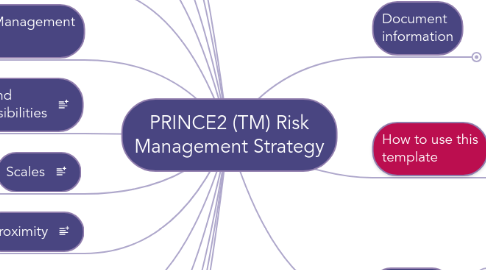
1. Tools and Techniques
1.1. [Refer to any risk management systems or tools to be used, and note any preference for techniques which may be used for each step in the risk management procedure]
2. Introduction
2.1. [State the purpose, objectives and scope, and identify who is responsible for the strategy]
3. Risk Management Procedure
3.1. The procedure should cover activities such as:
3.2. Identify
3.3. Assess
3.4. Plan
3.5. Implement
3.6. Communicate
4. Records
4.1. [Define the composition and format of the Risk Register and any other risk records to be used by the project]
5. Reporting
5.1. [Describe any risk management reports that are to be produced, including their purpose, timing and recipients]
6. Timing of Risk Management Activities
6.1. [State when formal risk management activities are to be undertaken - for example, at end stage assessments]
7. Roles and Responsibilities
7.1. [Define the roles and responsibilities for risk management activities]
8. Scales
8.1. [Define the scales for estimating probability and impact for the project to ensure that the scales for cost and time (for instance) are relevant to the cost and timeframe of the project. These may be shown in the form of probability impact grids giving the criteria for each level within the scale, e.g. for ‘very high’, ‘high’, ‘medium’, ‘low’ and ‘very low’]
9. Proximity
9.1. [Provide guidance on how proximity for risk events is to be assessed. Typical proximity categories will be: imminent, within the stage, within the project, beyond the project]
10. Risk Categories
10.1. [Define the risk categories to be used (if at all). These may be derived from a risk breakdown structure or prompt list.]
11. Risk Response Categories
11.1. [Define the risk response categories to be used, which themselves depend on whether a risk is a perceived threat or an opportunity]
12. Early-warning Indicators
12.1. [Define indicators to be used to track critical aspects of the project so that if certain predefined levels are reached, corrective action will be triggered.]
13. Risk Tolerance
13.1. [Define the threshold levels of risk exposure, which, when exceeded, require the risk to be escalated to the next level of management. (For example, a project-level risk tolerance could be set as any risk that, should it occur, would result in loss of trading. Such risks would need to be escalated to corporate or programme management).]
14. Risk Budget
14.1. [Describe whether a risk budget is to be established and, if so, how it will be used]
15. Sign-up FREE to edit this map
16. Document information
16.1. Project Name
16.1.1. [name]
16.2. Date
16.2.1. [date]
16.3. Release
16.3.1. Draft/Final
16.4. Author
16.4.1. [author]
16.5. Owner
16.5.1. [owner]
16.6. Client
16.6.1. [client]
16.7. Document Number
16.7.1. [number]
16.8. Revision, Approvals & Distribution
16.8.1. Revision History
16.8.1.1. Revision # [....]
16.8.1.1.1. Revision Date
16.8.1.1.2. Previous Revision Date
16.8.1.1.3. Summary of Changes
16.8.1.1.4. Changes Marked
16.8.1.2. Revision # [....]
16.8.1.2.1. Revision Date
16.8.1.2.2. Previous Revision Date
16.8.1.2.3. Summary of Changes
16.8.1.2.4. Changes Marked
16.8.1.3. Revision # [....]
16.8.1.3.1. Revision Date
16.8.1.3.2. Previous Revision Date
16.8.1.3.3. Summary of Changes
16.8.1.3.4. Changes Marked
16.8.1.4. Date of next revision:
16.8.1.4.1. [....]
16.8.2. Approvals
16.8.2.1. Approval # [....]
16.8.2.1.1. Name
16.8.2.1.2. Signature
16.8.2.1.3. Title
16.8.2.1.4. Date of Issue
16.8.2.1.5. Version
16.8.2.2. Approval # [....]
16.8.2.2.1. Name
16.8.2.2.2. Signature
16.8.2.2.3. Title
16.8.2.2.4. Date of Issue
16.8.2.2.5. Version
16.8.2.3. Approval # [....]
16.8.2.3.1. Name
16.8.2.3.2. Signature
16.8.2.3.3. Title
16.8.2.3.4. Date of Issue
16.8.2.3.5. Version
16.8.3. Distribution
16.8.3.1. Distribution # [....]
16.8.3.1.1. Name
16.8.3.1.2. Title
16.8.3.1.3. Date of issue
16.8.3.1.4. Version
16.8.3.2. Distribution # [....]
16.8.3.2.1. Name
16.8.3.2.2. Title
16.8.3.2.3. Date of issue
16.8.3.2.4. Version
17. How to use this template
17.1. How to share this template with your team
17.1.1. Send an email
17.1.1.1. 1. Click Share this map
17.1.1.2. 2. Select Invite People
17.1.1.3. 3. Write a message
17.1.1.4. 4. Click Invite
17.1.2. Send a link
17.1.2.1. 1. Click Share this map
17.1.2.2. 2. Tick Link to share
17.1.2.3. 3. Copy the link to share it
17.1.3. Export
17.1.3.1. 1. Click down arrow, bottom right
17.1.3.2. 2. Select the export option you want
17.2. How to complete this template
17.2.1. Complete the sections in square brackets
17.2.1.1. [....]
17.2.2. Read these sections for help on the template
17.2.2.1. Purpose
17.2.2.2. Advice
17.2.3. Navigate using the links in Contents
17.2.3.1. Contents
17.3. Attribution
17.3.1. Copyright © AXELOS Limited 2009. All rights reserved. Material is reproduced with the permission of AXELOS
17.4. Get this template here
18. Overview
18.1. Purpose
18.1.1. A Risk Management Strategy describes the specific risk management techniques and standards to be applied and the responsibilities for achieving an effective risk management procedure.
18.2. Contents
18.2.1. The Risk Management Strategy should cover the following topics.
18.2.2. Introduction
18.2.3. Risk Management Procedure
18.2.4. Tools and Techniques
18.2.5. Records
18.2.6. Reporting
18.2.7. Timing of Risk Management Activities
18.2.8. Roles and Responsibilities
18.2.9. Scales
18.2.10. Proximity
18.2.11. Risk Categories
18.2.12. Risk Response Categories
18.2.13. Early-warning Indicators
18.2.14. Risk Tolerance
18.2.15. Risk Budget
18.3. Advice
18.3.1. The Risk Management Strategy is derived from the: Project Brief; Business Case; The corporate or programme management’s risk management guide, strategy or policy.
18.3.2. A Risk Management Strategy can take a number of formats, including: Stand-alone document or a section in the Project Initiation Document; Entry in a project management tool.
18.3.3. The following quality criteria should be observed:
18.3.3.1. Responsibilities are clear and understood by both customer and supplier
18.3.3.2. The risk management procedure is clearly documented and can be understood by all parties
18.3.3.3. Scales, expected value and proximity definitions are clear and unambiguous
18.3.3.4. The chosen scales are appropriate for the level of control required
18.3.3.5. Risk reporting requirements are fully defined.
